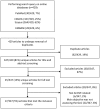Assessing quality of care of elderly patients using the ACOVE quality indicator set: a systematic review
- PMID: 22194872
- PMCID: PMC3241679
- DOI: 10.1371/journal.pone.0028631
Assessing quality of care of elderly patients using the ACOVE quality indicator set: a systematic review
Abstract
Background: Care of the elderly is recognized as an increasingly important segment of health care. The Assessing Care Of Vulnerable Elderly (ACOVE) quality indicators (QIs) were developed to assess and improve the care of elderly patients.
Objectives: The purpose of this review is to summarize studies that assess the quality of care using QIs from or based on ACOVE, in order to evaluate the state of quality of care for the reported conditions.
Methods: We systematically searched MEDLINE, EMBASE and CINAHL for English-language studies indexed by February 2010. Articles were included if they used any ACOVE QIs, or adaptations thereof, for assessing the quality of care. Included studies were analyzed and relevant information was extracted. We summarized the results of these studies, and when possible generated an overall conclusion about the quality of care as measured by ACOVE for each condition, in various settings, and for each QI.
Results: Seventeen studies were included with 278 QIs (original, adapted or newly developed). The quality scores showed large variation between and within conditions. Only a few conditions showed a stable pass rate range over multiple studies. Overall, pass rates for dementia (interquartile range (IQR): 11%-35%), depression (IQR: 27%-41%), osteoporosis (IQR: 34%-43%) and osteoarthritis (IQR: 29-41%) were notably low. Medication management and use (range: 81%-90%), hearing loss (77%-79%) and continuity of care (76%-80%) scored higher than other conditions. Out of the 278 QIs, 141 (50%) had mean pass rates below 50% and 121 QIs (44%) had pass rates above 50%. Twenty-three percent of the QIs scored above 75%, and 16% scored below 25%.
Conclusions: Quality of care per condition varies markedly across studies. Although there has been much effort in improving the care for elderly patients in the last years, the reported quality of care according to the ACOVE indicators is still relatively low.
Conflict of interest statement
Figures
Similar articles
-
Drugs for preventing postoperative nausea and vomiting in adults after general anaesthesia: a network meta-analysis.Cochrane Database Syst Rev. 2020 Oct 19;10(10):CD012859. doi: 10.1002/14651858.CD012859.pub2. Cochrane Database Syst Rev. 2020. PMID: 33075160 Free PMC article.
-
Signs and symptoms to determine if a patient presenting in primary care or hospital outpatient settings has COVID-19.Cochrane Database Syst Rev. 2022 May 20;5(5):CD013665. doi: 10.1002/14651858.CD013665.pub3. Cochrane Database Syst Rev. 2022. PMID: 35593186 Free PMC article.
-
Eliciting adverse effects data from participants in clinical trials.Cochrane Database Syst Rev. 2018 Jan 16;1(1):MR000039. doi: 10.1002/14651858.MR000039.pub2. Cochrane Database Syst Rev. 2018. PMID: 29372930 Free PMC article.
-
A rapid and systematic review of the clinical effectiveness and cost-effectiveness of paclitaxel, docetaxel, gemcitabine and vinorelbine in non-small-cell lung cancer.Health Technol Assess. 2001;5(32):1-195. doi: 10.3310/hta5320. Health Technol Assess. 2001. PMID: 12065068
-
Nutritional interventions for survivors of childhood cancer.Cochrane Database Syst Rev. 2016 Aug 22;2016(8):CD009678. doi: 10.1002/14651858.CD009678.pub2. Cochrane Database Syst Rev. 2016. PMID: 27545902 Free PMC article.
Cited by
-
Mapping Quality Indicators to Assess Older Adult Health and Care in Community-, Continuing-, and Acute-Care Settings: A Systematic Review of Reviews and Guidelines.Healthcare (Basel). 2024 Jul 12;12(14):1397. doi: 10.3390/healthcare12141397. Healthcare (Basel). 2024. PMID: 39057540 Free PMC article. Review.
-
The contribution of comprehensive geriatric assessment to primary care physicians.Isr J Health Policy Res. 2014 Dec 18;3(1):44. doi: 10.1186/2045-4015-3-44. eCollection 2014. Isr J Health Policy Res. 2014. PMID: 25584188 Free PMC article.
-
Raising enthusiasm for the medical care of elderly patients: a concept mapping study to find elements for an elderly friendly medical curriculum.BMC Med Educ. 2018 Oct 20;18(1):238. doi: 10.1186/s12909-018-1344-6. BMC Med Educ. 2018. PMID: 30342513 Free PMC article.
-
Tailoring implementation strategies for evidence-based recommendations using computerised clinical decision support systems: protocol for the development of the GUIDES tools.Implement Sci. 2016 Mar 5;11:29. doi: 10.1186/s13012-016-0393-7. Implement Sci. 2016. PMID: 26946141 Free PMC article.
-
Agreement of general practitioners with the guideline-based stepped-care strategy for patients with osteoarthritis of the hip or knee: a cross-sectional study.BMC Fam Pract. 2013 Mar 11;14:33. doi: 10.1186/1471-2296-14-33. BMC Fam Pract. 2013. PMID: 23497253 Free PMC article.
References
-
- Fulton MM, Allen ER. Polypharmacy in the elderly: a literature review. J Am Acad Nurse Pract. 2005;17:123–32. - PubMed
-
- Saliba D, Elliott M, Rubenstein LZ, Solomon DH, Young RT, et al. The Vulnerable Elders Survey: a tool for identifying vulnerable older people in the community. J Am Geriatr Soc. 2001;49:1691–9. - PubMed
-
- Rubenstein LV, Calkins DR, Greenfield S, Jette AM, Meenan RF, et al. Health status assessment for elderly patients. Report of the Society of General Internal Medicine Task Force on Health Assessment. J Am Geriatr Soc. 1989;37:562–9. - PubMed
-
- Rubenstein LZ, Goodwin M, Hadley E, Patten SK, Rempusheski VF, et al. Working group recommendations: targeting criteria for geriatric evaluation and management research. J Am Geriatr Soc. 1991;39:37S–41S. - PubMed
-
- Piccoliori G, Gerolimon E, Abholz HH. Geriatric assessment in general practice using a screening instrument: is it worth the effort? Results of a South Tyrol Study. Age Ageing. 2008;37:647–52. - PubMed
Publication types
MeSH terms
LinkOut - more resources
Full Text Sources


